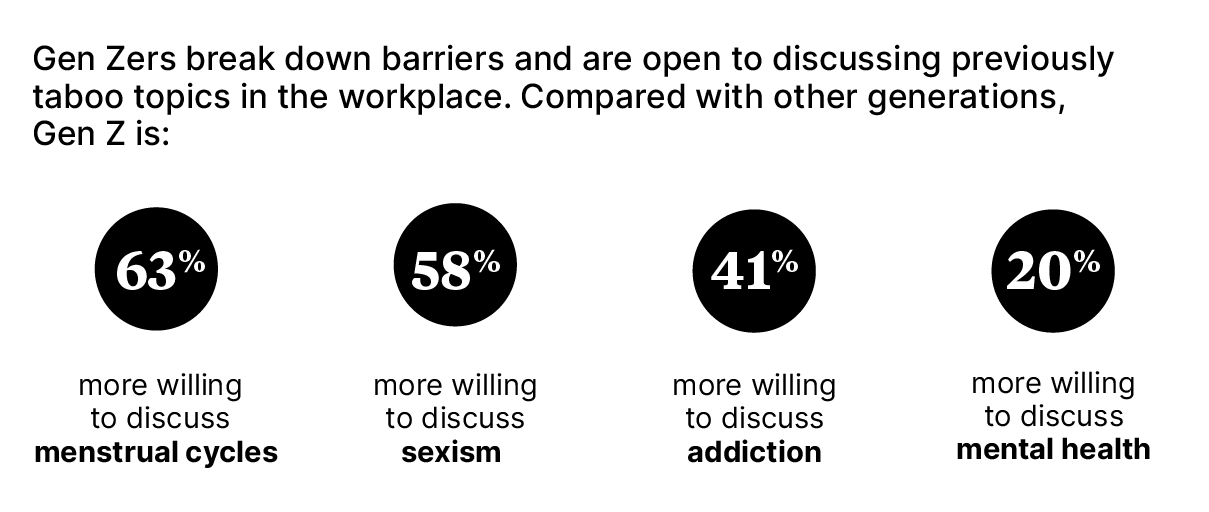Businesses have experienced a whirlwind of change to their workforces in the last few years. First, they slashed payrolls during the early days of the pandemic; then they spent the last two years rapidly refilling those empty positions (and then some).
Large numbers of older managers with decades of organizational knowledge walked out the door, often replaced by younger managers who, in turn, have been onboarding an even younger and very different set of Generation Z workers.
Even at companies where headcounts are largely the same, the churn has been massive. Now business leaders are trying to figure out how to connect with, inspire, and manage their remodeled workforces for the future.
The biggest mystery by far is Gen Z, which will account for a third of the global population by 2025. The level of disagreement among human resource teams and business leaders over flexible schedules, benefits, and other efforts to attract and retain these younger workers is unlike anything we have seen.
New research suggests employers can attract this extraordinary pool of talent if they are willing to set aside some of the practices that have worked in the past and meet Gen Zers where they are, on their terms. Those that don’t risk a continued disconnect among their generational workforces at best, and continued churning of talent and knowhow at worst.
A new generation
Born between 1997 and 2012, Gen Zers are confident, courageous, and committed to causes. The pandemic and social upheaval left them bruised but resilient, focused on personal wellness, and eager for careers that reflect their values.
Gen Zers expect fair pay, inclusive policies, and transparency — or they quit, according to two years of research by the Oliver Wyman Forum and The News Movement that includes surveys of 10,000 people in the United States and the United Kingdom. Gen Zers aren’t afraid to speak out, even at work, about infertility, mental health, and other once-taboo topics.
So what do Gen Zers demand at work?
Growth opportunities
While boomers and Gen Xers sacrificed to climb the career ladder, Gen Zers are unwilling to become another cog in the wheel. They view work as transactional and have a long list of demands. More than 60% are looking to job hop despite an uncertain economy, primarily because they want more pay, promotions, or personal fulfillment.
Women, especially, aren’t willing to wait. Almost 30% of those looking to make a switch cited better advancement and growth opportunities as a reason to leave a job, compared with 22% of men. What do these women want? In addition to more career opportunities, over 40% of them say they want greater clarity about internal promotions.
The lesson for companies is clear. They should aim to make their hiring processes more transparent. Gen Zers will use their internet skills and social networks to get the information anyway, so companies that save them the effort will stand out. Companies also should be more open about their review processes, and align job skills and pay scales across departments, to foster internal mobility.
Flexibility and wellness
Gen Zers are anything but regimented. Many of the oldest, who were onboarded during COVID-19 lockdowns, have grown used to the flexibility of remote work — the midday yoga class, lunch with friends, and the option to work at midday or midnight. While 15% would prefer to return to the office, the vast majority won’t stay at a company that doesn’t offer hybrid or fully remote options. “I love remote work because I thrive on flexibility,” said an environmental consultant we interviewed.
Gen Zers also want to control their career paths, pushing hard or slowing down as needed to accommodate family, reduce stress, or pursue outside interests. That reflects the priority this generation places on physical and mental wellness.
Gen Zers are willing to discuss numerous once-taboo health topics and want employers to provide the benefits that help them address these issues. Almost a third of Gen Zers, including 40% of the women, are comfortable talking about menstrual cycles, compared with 19% of other generations. Almost half of the younger generation believe women should have menstrual leave, compared with 30% of older colleagues.

Gen Z women also are very concerned about fertility issues, with 10% planning to undergo some sort of fertility treatment and 17% interested in freezing their eggs.
Companies that provide these and other benefits are more likely to attract and retain these employees — or at a minimum create enough brand loyalty that employees ready for their next career move look internally first.
Take a stand
Gen Zers want to work at companies that support their fight against climate change, sexism, and income inequality. Almost 40% said they would discuss sexism in the workplace, compared with 24% of older generations.
But talking isn’t enough. More than 20% said they would leave a job if employers didn’t engage on social issues. Yet engaging on social topics can be a double-edged sword for employers: Appealing to some workers means alienating others. Companies can accommodate this demand by being proactive and engaging with the board, employers, and other stakeholders to decide the issues on which they are willing to voice opinions.
Companies have an opportunity on social issues. Gen Zers are 39% more likely to trust their employers than the government. They believe one of the best ways to make change is to work from within — and that connecting on common causes is worth greater loyalty.
These generational and broader workforce changes are putting tremendous pressure on human resources, business, and legal teams struggling with retaining employees, redefining work boundaries, and fostering engagement. But those that can navigate these clashing forces can succeed in the battle for Gen Z talent.
People are eager to make up for all the experiences they missed during the pandemic, and that’s especially true of Generation Z. Ready to discover all the exotic adventures the world has to offer, these young consumers are prioritizing travel above other goods and services. They’re delaying many purchases, notably apparel, because of today’s high inflation rates, but 80% of them say they’re not willing to delay leisure travel, according to our latest Global Consumer Sentiment survey. And their desire for flexibility on the job — a whopping 85% of Gen Zers say they prefer hybrid or remote working arrangements — gives them the freedom to be footloose. This all holds great opportunity for the travel industry.
But companies face an uphill battle in capturing Gen Z’s heart. Only 8% of these young people have a favorite travel and hospitality brand, according to our survey, trailing industries like food and beverage, tech, entertainment, and apparel.
Airlines, hotels, restaurants, and the like should start by offering a great customer experience — something Gen Z values more than other generations. Fifty-three percent of Gen Zers say customer experience is a top characteristic among their favorite travel and hospitality brands, compared with 44% among other age brackets. Likewise, 59% of Gen Zers cite convenience as a top characteristic among their favorite travel and hospitality brands, compared with 52% of other generations. One way travel businesses can offer a seamless experience is to use technology to reduce or remove pain points.
For example, Azul Airlines introduced a new boarding process during the pandemic that projects a moving virtual carpet onto the floor of the terminal to guide passengers to the plane according to their seat number. “It removes all the stress, it makes things go a lot quicker,” said Azul President Abhi Shah at a SXSW event co-hosted by the Oliver Wyman Forum. Similarly, the Dallas/Fort Worth International Airport enables passengers to reserve a time slot for going through security checkpoints. “We’ve taken one pain point out of the customer journey,” said John Ackerman, the airport’s executive vice president who also participated in the event. “We’re trying to create an amazing experience, a frictionless experience.”

